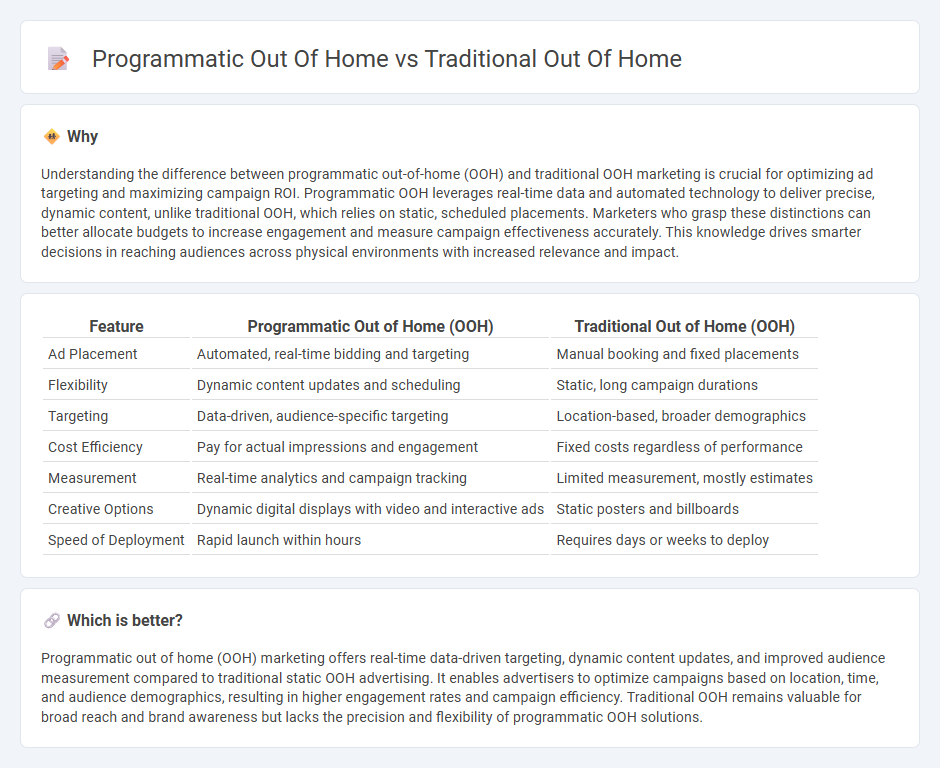
Programmatic Out of Home (DOOH) leverages real-time data and automation to deliver targeted advertising with precision and flexibility, surpassing traditional Out of Home (OOH) methods that rely on fixed placements and static content. DOOH enhances campaign effectiveness through dynamic content adjustments based on audience demographics, location, and time of day, optimizing engagement and ROI. Discover how integrating programmatic strategies can revolutionize your outdoor marketing efforts.
Why it is important
Understanding the difference between programmatic out-of-home (OOH) and traditional OOH marketing is crucial for optimizing ad targeting and maximizing campaign ROI. Programmatic OOH leverages real-time data and automated technology to deliver precise, dynamic content, unlike traditional OOH, which relies on static, scheduled placements. Marketers who grasp these distinctions can better allocate budgets to increase engagement and measure campaign effectiveness accurately. This knowledge drives smarter decisions in reaching audiences across physical environments with increased relevance and impact.
Comparison Table
| Feature | Programmatic Out of Home (OOH) | Traditional Out of Home (OOH) |
|---|---|---|
| Ad Placement | Automated, real-time bidding and targeting | Manual booking and fixed placements |
| Flexibility | Dynamic content updates and scheduling | Static, long campaign durations |
| Targeting | Data-driven, audience-specific targeting | Location-based, broader demographics |
| Cost Efficiency | Pay for actual impressions and engagement | Fixed costs regardless of performance |
| Measurement | Real-time analytics and campaign tracking | Limited measurement, mostly estimates |
| Creative Options | Dynamic digital displays with video and interactive ads | Static posters and billboards |
| Speed of Deployment | Rapid launch within hours | Requires days or weeks to deploy |
Which is better?
Programmatic out of home (OOH) marketing offers real-time data-driven targeting, dynamic content updates, and improved audience measurement compared to traditional static OOH advertising. It enables advertisers to optimize campaigns based on location, time, and audience demographics, resulting in higher engagement rates and campaign efficiency. Traditional OOH remains valuable for broad reach and brand awareness but lacks the precision and flexibility of programmatic OOH solutions.
Connection
Programmatic Out of Home (OOH) and Traditional Out of Home advertising are connected through their shared goal of reaching consumers in physical environments, leveraging location-based targeting and audience data. Programmatic OOH enhances traditional OOH by automating the buying process and enabling real-time ad placements across digital billboards and transit displays. This integration allows marketers to combine broad-reaching traditional ads with data-driven, dynamic campaigns, maximizing impact and efficiency.
Key Terms
Static Billboard
Static billboards deliver consistent, high-visibility advertising with minimal technological requirements, making them ideal for brand reinforcement in high-traffic locations. Programmatic out of home (OOH) enhances static billboard effectiveness by enabling dynamic ad rotation, precise audience targeting, and real-time campaign adjustments through digital interfaces. Explore how integrating programmatic capabilities with traditional static billboards can maximize advertising impact and campaign ROI.
Audience Targeting
Traditional out of home (OOH) advertising relies on fixed locations and broad demographic estimates, limiting precision in reaching specific audience segments. Programmatic out of home (pOOH) leverages real-time data, location analytics, and audience behavior to deliver highly targeted ads tailored to dynamic viewer profiles. Explore how programmatic OOH transforms audience targeting by maximizing relevancy and engagement.
Real-Time Bidding
Traditional out of home (OOH) advertising relies on fixed schedules and locations, limiting flexibility and targeting precision compared to programmatic out of home media. Programmatic OOH utilizes Real-Time Bidding (RTB) technology, enabling advertisers to purchase ad spaces dynamically based on real-time data and audience insights, optimizing campaign efficiency and reach. Explore how RTB-driven programmatic OOH transforms outdoor advertising with enhanced targeting and real-time responsiveness.
Source and External Links
Traditional vs. Digital Out-of-Home - Key Differences | Char - Traditional out-of-home (OOH) advertising uses static formats like billboards, posters, and transit ads fixed in high-traffic areas, offering long-term brand exposure and cost-effectiveness compared to digital OOH options.
traditional out-of-home media | emc outdoor - Traditional out-of-home includes familiar formats such as billboards and posters placed where people frequent, leveraging size and location to deliver effective visibility and brand presence.
The timeless value of traditional out-of-home (OOH) in a programmatic era - Traditional OOH involves static physical displays like billboards and street furniture that ensure guaranteed exposure without sharing ad space, maintaining 64% of OOH spending and strong relevance in advertising.
 dowidth.com
dowidth.com